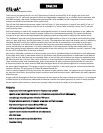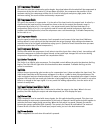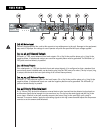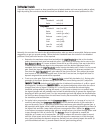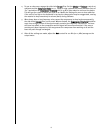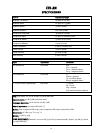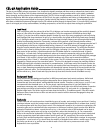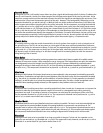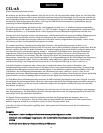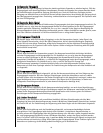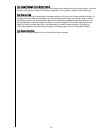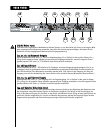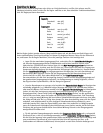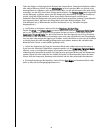
12
AAccoouussttiicc GGuuiittaarr
If the guitar is mic’d, it will usually have a darker tone than a signal derived through a built-in pickup. To address the
tone of a mic’d acoustic, the key is to allow enough of the initial percussive phase of the tone to pass intact. At the
same time, enough control must be exercised to prevent the tail of the signal from overlapping the next strum. If the
ambient noise is low, leave the expansion gate out of the path. However, if the background is distracting, set the
expansion threshold at -40 and the ratio at 1:2. While this will not yield a studio-level noise floor, it will reduce the
noise to some extent without chopping off the ring of the instrument. On the compressor, try setting the threshold
at -5 and the ratio at 2:1 for a light touch on the peaks. If the guitarist uses a pick, place the attack control around
35mS and the release at .5S. For finger picking, use a slower attack of 50mS and a release of .4S. The limiter can be
set at 15 with the de-esser off. If the guitar is a Dreadnought or other bass heavy style, the low-cut filter can be left
out unless the sound becomes boomy, then engaged on a trial basis. For smaller instruments, the low-cut filter may
be more appropriate, especially if other instrumentation is present in the mix. Acoustic guitars with built-in bridge
pickups may use the above settings with slightly quicker attack times and a higher 3:1 compression ratio.
EElleeccttrriicc GGuuiittaarr
It is usually unwise to alter the sustain characteristics of electric guitars since sustain is such an integral part of
the guitarist’s tone. The CEL-2A can best serve as a noise gate for tube amps and floor-based effects processors
and as a final limiter for unforeseen incidents. To that end, the expansion gate threshold may be placed at -30 with
a gate ratio of 1:3. The compressor can be left out of the signal path, unless the guitarist cannot or will not control
the dynamic range. A limiter setting of 12 will allow enough room for screaming leads, but with the assurance
things won’t get out of control.
BBaassss GGuuiittaarr
Neck-through bodies and innovative tensioning systems have made today’s basses capable of incredible sustain.
However, for even more sustain, a little compression can go a long way. If the bass and amp are quiet, the expansion
can be bypassed, but may be brought in as with the electric guitar if necessary. Maintaining consistent volume
among all the strings is made easier with the CEL-2A. Start by setting the downward expander threshold at -35 and
the ratio at 1:2.5. The compressor’s threshold can be placed at -10, the ratio at 3:1, attack at 30mS and release at .5S.
KKiicckk DDrruumm
Allowing the initial phase of the beater/head contact to pass unaltered is a key component in maintaining peace with
the drummer. Compression can begin after the aural signature of the kick drum is past. Set the compressor’s threshold
at -5, the ratio at 4:1, the attack at 20mS, and the release at .2S and the limiter at 15. For the expander, try a threshold
setting of -30 and the ratio at 1:2 to keep the passages between beats quiet. For toms, a similar arrangement can be
made with some tweaking probably necessary on the expander to keep ambient noise out of each mic.
RReeccoorrddiinngg
Sometimes there is nothing worse than a recording made directly from a board mix. A compressor can improve the
situation by reducing the excessive dynamic range of a live event to a manageable level and by preventing
overshoots onto tape. If recording to cassette, a compressor can also keep the recording out of the noise floor.
Set the expander threshold to -30 with a ratio of 1:2. The compressor’s threshold can be positioned at -15, with a
ratio of 4:1, an attack around 20mS and a release of .5S.
MMoonniittoorr WWoorrlldd
If individual channels can be used, detailed control over monitors is possible. The key is to set the threshold high but
hit the signal hard to prevent feedback instead of increasing feedback, as compressors can sometimes do. The
expander must be set low, with a threshold of -40 and a ratio of 1:1.5 to 2. The compressor’s threshold must be set at
0, with a strong ratio of 5:1 or higher, a quick attack of 25mS and a release of .3S. If the vocalists push harder against
the compressor, feedback and frustration can occur, making the bypass switch a handy tool in monitor world.
BBrrooaaddccaasstt
Keeping as much level as hot as possible for as long as possible is the goal. To that end, the expander can be
ignored or set nominally at -45 threshold and 1:1.5 ratio. The compressor’s ratio, however, can be set at 6:1, with a
threshold of -20 and an attack of 15mS and a release time of .6S.



